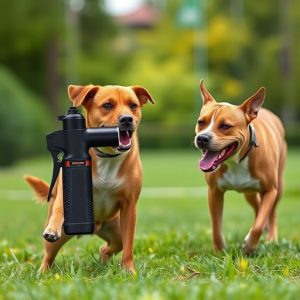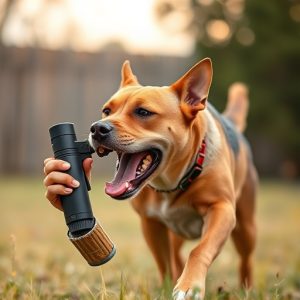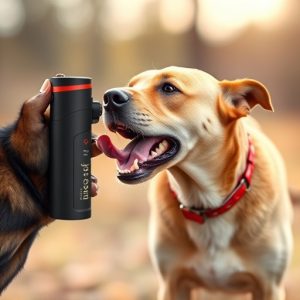Dog Deterrent Spray Range: Understanding OC Percentage Impact
The OC (Oleoresin Capsicum) percentage in canine pepper spray determines its potency, effective rang…….
The OC (Oleoresin Capsicum) percentage in canine pepper spray determines its potency, effective range, and ability to temporarily incapacitate dogs by irritating their eyes, nose, and throat. Higher OC% values offer longer-lasting deterrence but should be used responsibly to avoid causing harm or undue distress to animals. Environmental factors like wind and humidity also significantly impact the dispersion and effectiveness of the spray. Understanding these aspects is crucial for optimal use in self-defense scenarios involving aggressive dogs.
“Uncover the secrets behind dog deterrent spray’s effective range, a crucial aspect for pet owners and professionals alike. This comprehensive guide explores the power of canine pepper spray, delving into its active ingredient—OC (Oleoresin Capsicum) percentage—and its impact on reach and efficacy. Learn how this unique compound repels dogs, understanding factors that influence its performance. From application techniques to environmental considerations, gain insights to ensure maximum protection for your space.”
- Understanding Canine Pepper Spray: What It Is and How It Works
- The Role of OC Percentage in Determining Effective Range
- Factors Affecting the Reach and Efficacy of Dog Deterrent Spray
Understanding Canine Pepper Spray: What It Is and How It Works
Canine pepper spray, also known as dog deterrent spray, is a non-lethal self-defense tool designed to temporarily incapacitate dogs and deter aggressive behavior. Unlike traditional pepper spray formulated for humans, canine versions are tailored to be more potent yet less harmful to animals. The primary active ingredient in most dog deterrent sprays is capsaicin, the same compound that gives chili peppers their heat. However, what sets canine pepper spray apart is its OC (oleoresin capsicum) percentage—a measure of capsaicin concentration.
The OC percentage in canine pepper spray can vary from 10% to 25%, with higher concentrations offering longer-lasting and more intense deterrence. This compound irritates the dog’s eyes, nose, and throat, leading to temporary blindness, coughing, and difficulty breathing. When sprayed, it creates a cloud of residue that lingers, ensuring the dog avoids the treated area for some time. Understanding the OC percentage is crucial as it determines the spray’s effectiveness range—the distance at which it can be effectively applied to deter an approaching dog.
The Role of OC Percentage in Determining Effective Range
The effectiveness of dog deterrent spray, often referred to as canine pepper spray, is closely tied to its Oc (Oleoresin Capsicum) percentage and how it impacts the range at which it can deter a canine. The OC Percentage is a measure of the concentration of capsaicin, the active ingredient responsible for the burning sensation associated with chili peppers. A higher OC% generally translates to a longer effective range. This is because capsaicin irritates the dog’s eyes and respiratory system, causing them to back away due to discomfort.
Manufacturers often provide guidelines on the expected effective range based on specific OC percentages. For instance, a spray with 10% OC might have an effective range of about 4-5 meters (13-16 feet), while a higher concentration like 20% OC could double or even triple that range. Understanding this relationship between OC Percentage and range is crucial for users to deploy the spray appropriately and ensure it has the desired impact on deterring aggressive dogs without causing harm or unnecessary distress.
Factors Affecting the Reach and Efficacy of Dog Deterrent Spray
The reach and effectiveness of dog deterrent spray, often containing capsaicin or canine pepper spray, are influenced by several key factors. One of the primary considerations is the OC (Oleoresin Capsicum) percentage in the spray. Higher concentrations of OC ensure a more potent impact, increasing the spray’s ability to deter dogs over a longer distance. This is crucial for outdoor applications where maintaining a strong deterrent effect across a wide area is essential.
Environmental conditions play a significant role as well. Wind patterns and humidity levels can affect how the spray disperses and its overall potency. In windy areas, the spray might not reach its intended target effectively, while high humidity could reduce the concentration of capsaicin in the spray, diminishing its impact. Therefore, understanding these factors is vital for maximizing the dog deterrent spray’s range and ensuring its reliability in various settings.
Dog deterrent spray, particularly those with a high OC (Oleoresin Capsicum) percentage, offer an effective way to manage and control aggressive canine behavior. The range of these sprays is influenced by various factors, including the concentration of OC, weather conditions, and the dog’s size and speed. Understanding the OC Percentage is key to determining the spray’s effective reach, ensuring it provides a safe and controlled deterrent for both dogs and their owners in need.


